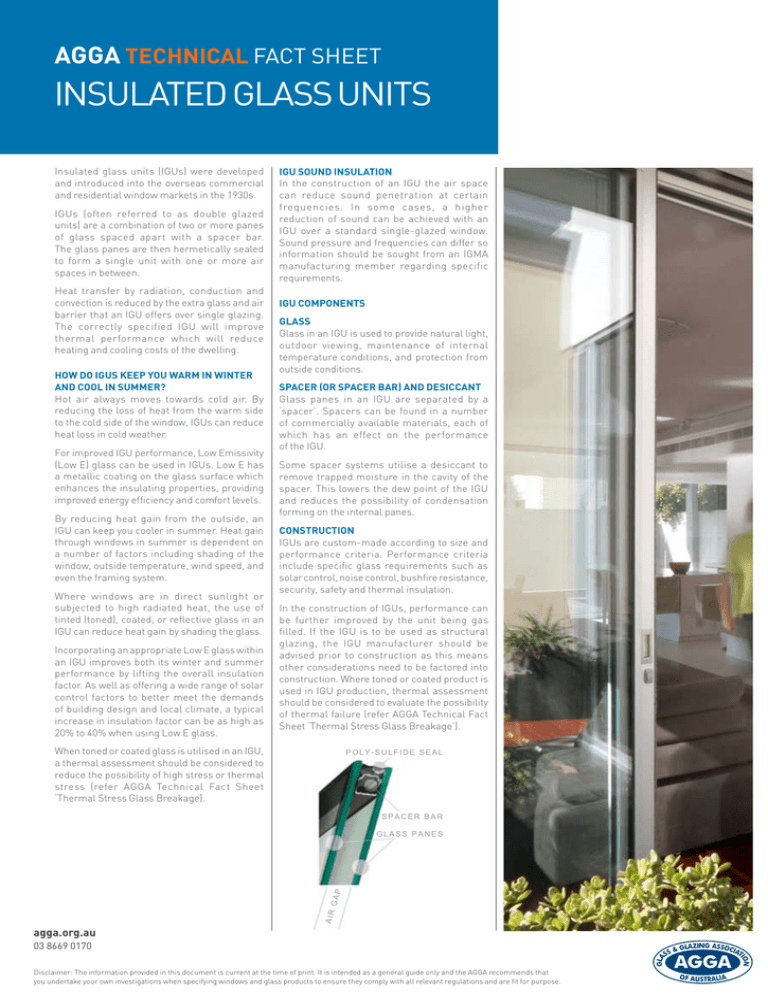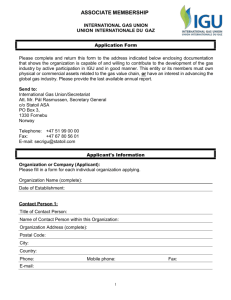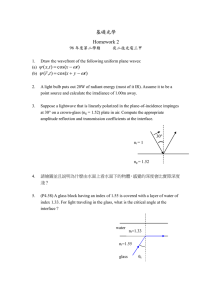InSulATEd GlASS unITS
advertisement

AGGA TECHNICAL FACT SHEET Insulated Glass Units Insulated glass units (IGUs) were developed and introduced into the overseas commercial and residential window markets in the 1930s. IGUs (often referred to as double glazed units) are a combination of two or more panes of glass spaced apart with a spacer bar. The glass panes are then hermetically sealed to form a single unit with one or more air spaces in between. Heat transfer by radiation, conduction and convection is reduced by the extra glass and air barrier that an IGU offers over single glazing. The correctly specified IGU will improve thermal performance which will reduce heating and cooling costs of the dwelling. How do IGUs keep you warm in winter and cool in summer? Hot air always moves towards cold air. By reducing the loss of heat from the warm side to the cold side of the window, IGUs can reduce heat loss in cold weather. For improved IGU performance, Low Emissivity (Low E) glass can be used in IGUs. Low E has a metallic coating on the glass surface which enhances the insulating properties, providing improved energy efficiency and comfort levels. By reducing heat gain from the outside, an IGU can keep you cooler in summer. Heat gain through windows in summer is dependent on a number of factors including shading of the window, outside temperature, wind speed, and even the framing system. Where windows are in direct sunlight or subjected to high radiated heat, the use of tinted (toned), coated, or reflective glass in an IGU can reduce heat gain by shading the glass. Incorporating an appropriate Low E glass within an IGU improves both its winter and summer performance by lifting the overall insulation factor. As well as offering a wide range of solar control factors to better meet the demands of building design and local climate, a typical increase in insulation factor can be as high as 20% to 40% when using Low E glass. IGU Sound Insulation In the construction of an IGU the air space can reduce sound penetration at certain frequencies. In some cases, a higher reduction of sound can be achieved with an IGU over a standard single-glazed window. Sound pressure and frequencies can differ so information should be sought from an IGMA manufacturing member regarding specific requirements. IGU Components Glass Glass in an IGU is used to provide natural light, outdoor viewing, maintenance of internal temperature conditions, and protection from outside conditions. Spacer (or Spacer Bar) and Desiccant Glass panes in an IGU are separated by a ‘spacer’. Spacers can be found in a number of commercially available materials, each of which has an effect on the performance of the IGU. Some spacer systems utilise a desiccant to remove trapped moisture in the cavity of the spacer. This lowers the dew point of the IGU and reduces the possibility of condensation forming on the internal panes. Construction IGUs are custom-made according to size and performance criteria. Performance criteria include specific glass requirements such as solar control, noise control, bushfire resistance, security, safety and thermal insulation. In the construction of IGUs, performance can be further improved by the unit being gas filled. If the IGU is to be used as structural glazing, the IGU manufacturer should be advised prior to construction as this means other considerations need to be factored into construction. Where toned or coated product is used in IGU production, thermal assessment should be considered to evaluate the possibility of thermal failure (refer AGGA Technical Fact Sheet ‘Thermal Stress Glass Breakage’). When toned or coated glass is utilised in an IGU, a thermal assessment should be considered to reduce the possibility of high stress or thermal stress (refer AGGA Technical Fact Sheet ‘Thermal Stress Glass Breakage). agga.org.au 03 8669 0170 Disclaimer: The information provided in this document is current at the time of print. It is intended as a general guide only and the AGGA recommends that you undertake your own investigations when specifying windows and glass products to ensure they comply with all relevant regulations and are fit for purpose. AGGA TECHNICAL FACT SHEET Insulated Glass Units Sealants Polyisobutylene, thermoplastic and butyl are generally used as the primary seal or first barrier (for eliminating moisture penetration). For best adhesion in an IGU, sealants are applied at the sealant manufacturer’s recommended temperature. Gas Fill To improve thermal efficiency, gas filling of IGU is offered by manufacturers. Inert gases such as Argon and Krypton replace the air in the internal cavity of the unit. Sulfur hexafluoride can be used to improve the IGU’s soundabsorbing qualities. Two part polysulfide is an organic sealant used for secondary or outer seal material. Careful consideration must be given to potential breakdown of the outer seal when exposed to direct UV light, and to a degree, indirect UV light. These will also depend on glass type. High Altitude Installation It is recommended that pressure equalisation tubes be considered where the intended installation of an IGU is 800 meters above its point of manufacture. Two part polyurethane is another type of organic sealant, which can be used for the secondary or outer seal. Manufacturers claim this sealant offers a greater degree of stability when exposed to UV light. Terminologies Associated with IGU Performance U-Value: The flow rate of heat through an IGU or window system. The lower the U value, the less heat that is transmitted into the dwelling. Can be variable due to climatic conditions. Adhesion to ‘substrates’ (glass and spacer combination), water vapour transmission rate, gas permeability, mechanical stress, and ‘elongation break’ will differ slightly depending on the sealant brand. R-Value: Thermal resistance of the IGU or window system. The higher the R value, the less heat that is transmitted into the dwelling. Can be variable due to climatic conditions. Silicone, as a secondary or outer seal, is an inorganic sealant and considered to have excellent durability and longevity in the IGU. Silicone also offers high UV stability and superior performance in extreme weather conditions. Silicone produced for IGUs is believed to be the ‘premium seal’, and should be the major product consideration in structural, commercial and complex roof glazing applications. Compatibility Whilst the best sealants and manufacturing processes can be utilised in IGU manufacture, it is compatibility of glazing, glazing systems and sealants that need to be carefully considered. Wrong or uninformed choices can lead to premature failure of the IGU. Over 80% of installed IGUs fail due to incorrect glazing or glazing systems.1 Desiccants Desiccant has a dual function in IGUs. Firstly, it absorbs moisture and organic vapour that is encapsulated at the time of IGU manufacture. Secondly, it absorbs moisture that may penetrate the secondary seal until a point of saturation is reached. The main desiccant used in IGU manufacture is a ‘3A molecular sieve’ in either a ‘bead’ or ‘matrix’ form depending on the spacer bar system used in unit manufacture. Shading Coefficient: Indicates the amount of solar energy that passes through glass compared to 3mm clear float glass. The lower the shading coefficient value, the lower the level of heat entering the interior. A low U-Value is ideal for all climates as it stops unwanted heat gain in summer and unwanted heat loss in winter. Solar Heat Gain Coefficient (SHGC): Total amount of solar energy transmittance entering the interior through the glazing as heat gain. This measurement equates to the sun’s direct transmittance of energy, plus energy absorbed by the glass and re-radiated inside. The lower the number, the less the heat gain. This is a component considered in determining the cooling and heating loads of a dwelling. Visible Light Transmission: Percentage of interior daylight that an IGU or glass type lets pass through it. The higher the number the brighter the interior should be. UV Transmission: Percentage of the sun’s harmful ultra violet light (UV) that is transmitted through the glass. UV light is one of the main components of sunlight and is responsible for fading and damaging furnishings and occupants. In cooler climates, a high SHGCw (as illustrated) is beneficial for north facing windows during winter, however shading will be required in summer to prevent unwanted solar heat gain. In hot climates, a low SHGCw is always ideal. Spectral Selectivity: A term for a glass product that permits portions of the solar spectrum to enter the interior while blocking others. The glass product allows as much natural lighter as possible while reducing as much solar heat as possible. This aids in reducing energy costs. Spacer Bar Through years of development, IGU spacer bar suppliers offer industry and consumers a wide range of products to meet all performance criteria. Current materials available are aluminium, steel, stainless steel, thermoplastic, plastic and ‘Super Spacer’ to mention a few. 1 IGMA North America’s Glazing Guidelines Ideal for all climates, a high Tvw maximises natural light. agga.org.au 03 8669 0170 Disclaimer: The information provided in this document is current at the time of print. It is intended as a general guide only and the AGGA recommends that you undertake your own investigations when specifying windows and glass products to ensure they comply with all relevant regulations and are fit for purpose. AGGA TECHNICAL FACT SHEET Insulated Glass Units Meeting Consumer Expectations Glass can provide multiple solutions to meet the requirements of most IGU specifications. Glass in IGUs is able to provide comfort levels with a multitude of design options to accommodate modern living. Low Emissivity Coated Clear or Tinted Glass These products fall into two groups: Hard Coat ‘Pyrolytic Chemical Vapour Deposition’ uses a combination of chemicals applied in very fine quantities during primary manufacture on the float line. This process forms multiple layers of coating. These layers are physically fused to the glass surface and are typically harder than the glass itself, hence commonly referred to as ‘hard coat’. Soft Coat ‘Magnetron spluttering’ is the process of developing ‘soft coats’. It involves depositing multiple layers of coatings applied in a number of vacuum chambers at lower temperature on glass received straight from the manufacturing lines. These Low E products are generally not used in applications where they are exposed to the atmosphere i.e. applications other than where it is protected within an IGU, and require some level of additional care in processing. Due to the additional heat resistance offered by Low E glass, information should be sought from your IGU manufacturer regarding thermal stability. Tinted or Toned Glass Tinted glass reduces the sun’s direct heat energy by 30% to 50% depending on glass thickness and colour or tint/tone. The glass absorbs the radiant energy allowing itself to become hotter. This heat ultimately is re-radiated by the glass both inside and outside the window. Information should be sought from your IGU manufacturer regarding thermal stability. Laminated Glass Low E, toned, painted or printed, and clear or obscure laminates can be utilised in the makeup of an IGU. Information should be sought from your IGU manufacturer regarding thermal stability. IGU Inherent Conditions Multi Reflection Multiple reflections can be present when objects are reflected in an IGU. The use of toned or reflective glass as an outside skin, and a Low E glass as an internal skin, increases the possibility of reflection. Whilst this is not a common situation, a certain amount of double imaging is inherent in IGUs. Newton’s Rings In a large IGU, the two glass panes can be displaced by wind load or air pressure, causing them to touch in the centre of the unit. If this occurs, a circular band similar to an oily stain on water may develop. Newton’s rings can only happen at the centre of the unit and are generally attributed to excessive wind load, under-specified glass thickness, or underspecified cavity width. IGUs that are to be installed 800 meters above the manufacturing conditions should consider pressure equalisation tubes to eliminate any possibility of Newton’s rings. Brewsters Fringes Brewsters Fringes are not a fault. They can occur only in very high-quality float glass IGUs, and are a consequence of the thickness of the two panes being so accurately similar and their surfaces so flat that the multiple reflections of light within one pane can combine with those similarly reflected within the other. The effect is faint coloured bands or irregular shapes which can be located anywhere over the surface. It is rarely noticeable in normal lighting conditions. Deflection and Reflection With typical IGU constructions, small changes in temperature are sufficient to cause changes in reflection due to glass deflection. The appearance can be convex distortion when the glass pane is bowing outwards, and concave distortion when bowing inwards. These distortions are an inevitable consequence of the laws of physics. Preferential Wetting Patterns IGU manufacturing and fabrication processes utilise numerous tools and means to produce and install IGUs. These devices include, but are not limited to, conveyor belting, rollers, brushes, vacuum lifting aides, separation pads and labels. These devices do not normally leave a residue on the glass surfaces; however they do change the surface condition of the glass which may provide a visual appearance under certain conditions. One such condition may be seen when the glass surface has become wet from rain, condensation or washing. Different water beading patterns can create an outline with distinct lines or patterns that can take the shape of the device that has come in contact with the glass surface. Whilst this appearance is noticeable under certain conditions it does not affect the functionality, performance or longevity of the IGU and is not a basis for rejection or defect of the IGU. This effect should not be mistaken for staining. It is possible that the effect of preferential wetting patterns may dissipate over time as a consequence of normal surface weathering. Photoelasticity The variation of stress across the surface of toughened glass is due to the thermal toughening process. This process can result in varying degrees of light and dark areas being visible (sometimes called leopard spots) when polarised light is incident on the panel. This phenomenon is more noticeable when increasing polarised light and glass thickness. The photoelastic effect is an inherent characteristic of heat treated glass. IGU manufacturers endeavour to minimise this phenomenon but it becomes accentuated if two panels of heat-treated glass are used in IGU makeup. Australian Standards which impact on IGU Manufacture and Selection AS/1288: Specifies procedures for design, selection and installation of glass in buildings. AS/2047: Windows in buildings - selection and installation AS/4055: Wind loads for housing AS/NZ1170.0 and ASII70.2: Structural design actions general principles and wind actions AS/1199: sampling procedures for inspection by attributes. Sampling schemes indexed by acceptance quality limit for lot by lot inspection. AS/NZS2208: Safety Glazing Material. The criteria for safety glass compliance. AS/NZ4666 (2000): Performance requirements and guidelines on selection and installation of IGU AS/NZ4667: Quality requirements for cut to size and processed glass. AS/1530.4: Methods for Fire tests on building materials, components and structures Warranties and Guarantees These will be determined by the IGU manufacturer and the confidence his or her organisation has in their quality assurance system. IGUs manufactured by IGMA members are warranted for ten years, however this should be confirmed at purchase. IGMA North America’s Glazing Guidelines agga.org.au 03 8669 0170 Disclaimer: The information provided in this document is current at the time of print. It is intended as a general guide only and the AGGA recommends that you undertake your own investigations when specifying windows and glass products to ensure they comply with all relevant regulations and are fit for purpose.


